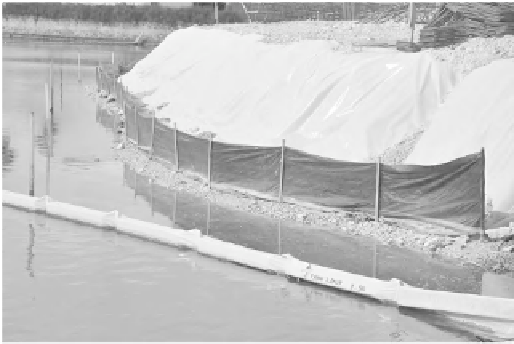Environmental Engineering Reference
In-Depth Information
A least-squares regression analysis on log
10
c
versus
log
10
Q
(where log
10
c
=
a
+
b
log
10
Q
) yields
a
= 0.9856,
b
= 0.4199, and a standard error of
s
= 0.1372. Using
these data gives the following filled-in suspended solids
loads shown in bold:
niques are broadly defined as methods that do not
require physical alteration of a watercourse. Structural
techniques require physical alteration of a watercourse,
such as the use of riprap for bank stabilization.
4.8.1 Nonstructural Techniques
Flow (m
3
/s)
Day
Suspended Solids (mg/L)
nonstructural techniques for the restoration and man-
agement of streams typically include administrative or
legislative policies and procedures that limit or regulate
some activity. The most common nonstructural tech-
niques are described below.
1
1.0
10
2
1.5
11
3
15.0
30
4
100.0
67
5
20.0
40
6
10.0
18
Flow regulation
consists of reserving or reclaiming
flow for in-stream uses, such as fishing, wildlife,
and recreation.
Plantings
create buffer zones that can be gradually
reforested over time through planting of trees,
brush, herbaceous vegetation, and grass. Strips of
forest along both banks of a stream protect the
stream from polluted runoff. Important consider-
ations in reforestation of stream riparian zones
include site assessment, soil preparation, species
selection, planting techniques, and
7
5.0
19
8
2.5
20
9
1.5
11
10
1.0
8
which yields
N
∑
L
r
=
c Q t
j
∆
=
[
(10)(1.0)
+
(4)(1.5)
+
(38)(15.0)
j
j
=
1
long-term
+
(246)(100.0)
+
(40)(20.0)
+
(18)(10.0)
+
(13)(5.0)
maintenance.
Pollution prevention techniques
include regulating
activities in the stream, riparian zone, and sur-
rounding watershed. For example, phasing con-
struction to limit the amount of disturbed area at
any given time greatly reduces downstream sus-
pended sediment levels. The utilization of silt
fences, such as shown in Figure 4.21, to protect
rivers from dislodged soil during construction is an
effective pollution-prevention technique. Typi-
cally, silt fences are installed alongside water
bodies but may also be used effectively anywhere
there is a risk of erosion. Silt fences are temporary
+
(20)(2.5)
+
(4)(1.5)
+
(8)(1.0) 86 4
](
. ) =
718,800
kg
L
=
L
exp
(2.651 )
s
2
=
(718 800)
,
exp
[2.651(0.1372) ]
2
cr
r
=
755,600
kg
.
overall, the range of 10-day loadings indicated by the
data is 114,500-755,600 kg.
In general, loads derived from the aforementioned load
estimation methods become more accurate with more
frequent synoptic sampling of flows and concentrations.
However, for any given sampling frequency and load
estimation method, the accuracy of the estimated con-
taminant load depends on the temporal distribution of
loads that is unique to a particular location. In so-called
flashy watersheds where runoff events are short and
intense, load estimation methods generally yield signifi-
cant underestimates of contaminant load (e.g., Cassidy
and Jordan, 2011).
4.8 MANAGEMENT AND RESTORATION
The primary water-quality related problems encoun-
tered in streams include: (1) excessive pathogen levels;
(2) siltation; (3) habitat alterations; (4) low oxygen
levels; and (5) excessive nutrient levels. Techniques that
can be used in stream restoration are divided into non-
structural and structural techniques. nonstructural tech-
Figure 4.21.
Silt fence.




Search WWH ::

Custom Search